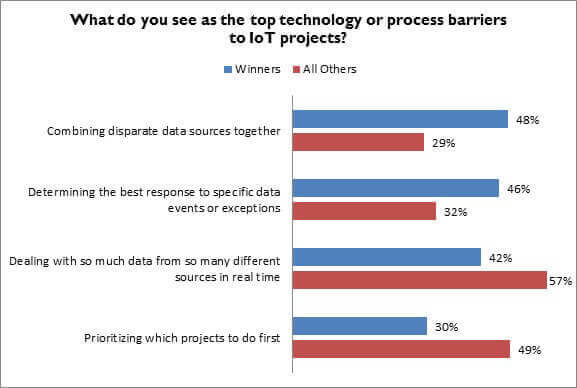The Internet Of Things: Data Will Be The Problem
In our first-ever study on the Internet of Things, retailers were quite candid with their responses. Despite their optimism for all of the opportunities they think these new connected devices will ultimately bring to their enterprises, retailers already know they face significant internal challenges before they’ll be able to leverageany of the opportunities they perceive from the IoT.
By performance, Winners even say they face an entirely different set of implementation challenges. In the figure, below, we can see that getting to data – regardless of what state it’s in – presents a problem to all retailers. But note the primary difference: Winners see their biggest tech and process barriers in the future as the ability to generate a powerful offering from the data they’ll be collecting from various sources.
By contrast, their peers can’t get their heads around what it will mean when data is coming in from so many sources at one time. This may seem subtle, but it indicates that non-winning retailers likely already have a tough time collecting data and making it actionable. The deluge that will result from the Internet of Things will not make life any easier on them.
Figure: Data, Data, Everywhere

Source: RSR Research, August 2015
Winners are also less challenged to prioritize which projects they want to tackle first. While roughly one in three Winners view the “triage ” process as a challenge, that number is nearly one in two for all other retailers. This is not an uncommon occurrence; in much of the research RSR conducts, we find Winners routinely display a calmer nature while prioritizing new projects. Part of this comes from their early awareness of emerging technologies: paying more attention to trade publications, attending more industry events, and the like.
However, it is also a function of Winning behavior: don’t try to boil the ocean – start with small, achievable goals, put a dedicated exploratory team together with realistic targets, and get to work. The process may seem trivial at first, but this is how progress is made. Viewing a new technology as “too big ” to tackle or panicking about where to begin is a sure-fire way to become a late (and likely less-effective) attendee to the party.
Interestingly enough, by vertical, retailers selling Fast-moving Consumer Goods (FMCG) are inordinately challenged to combine their disparate data sources together. While fashion, general merchandise and hard goods retailers are far more challenged to combine IoT data with things like predictive analytics, 50% of FMCG retailers cite combining their disparate data sources together as a top-three implementation challenge (not pictured). Theirs will be a long and painful road before they can glean actionable information from IoT sources. The complexity of their supply chains, coupled with the number of SKUs and often-times perishability of those goods makes these retailers ideal candidates to leverage benefits from IoT devices and technologies; just think of the possibilities!
However, as we’ve said for many years now, it will be a long time before next-generation tracking technologies are inexpensive enough to warrant following a can of peas, even if the law of physics would allow it.
We invite all Retail Paradox Weekly readers to read the full report, which is available here.
